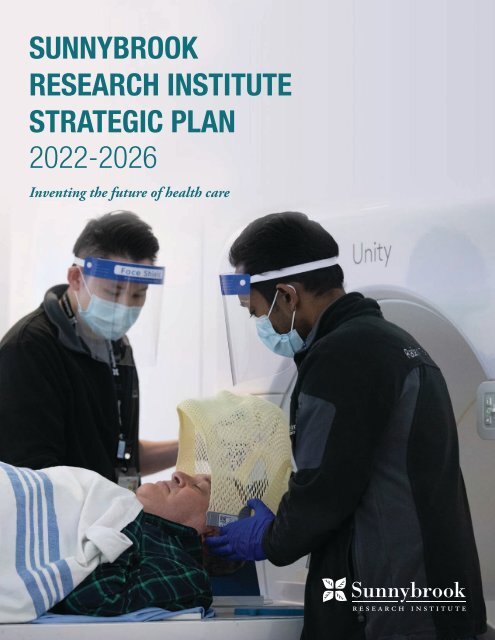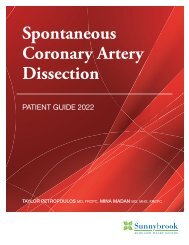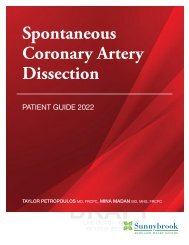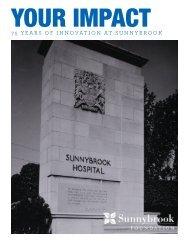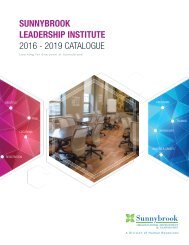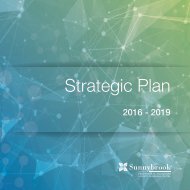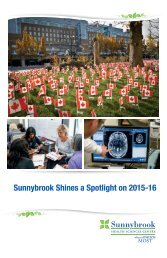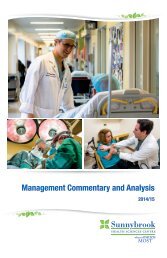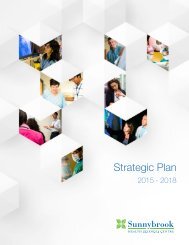Sunnybrook Research Institute Strategic Plan 2022-2026
Inventing the future of health care
Inventing the future of health care
Create successful ePaper yourself
Turn your PDF publications into a flip-book with our unique Google optimized e-Paper software.
SUNNYBROOK<br />
RESEARCH INSTITUTE<br />
STRATEGIC PLAN<br />
<strong>2022</strong>-<strong>2026</strong><br />
Inventing the future of health care<br />
SRI <strong>Strategic</strong> <strong>Plan</strong> <strong>2022</strong>-26 1
SUNNYBROOK<br />
RESEARCH INSTITUTE<br />
STRATEGIC PLAN<br />
<strong>2022</strong>-<strong>2026</strong><br />
Inventing the future of health care<br />
VISION<br />
<strong>Sunnybrook</strong> invents the future of health care.<br />
MISSION<br />
Integrate research with health care delivery<br />
across <strong>Sunnybrook</strong> to drive clinical<br />
excellence, innovation and commercialization.<br />
VALUES<br />
Excellence<br />
Collaboration<br />
Accountability<br />
Respect<br />
Engagement<br />
PARTNERSHIPS<br />
Our vision and mission will only be possible<br />
with the close collaboration of <strong>Sunnybrook</strong>,<br />
<strong>Sunnybrook</strong> Foundation, our patients,<br />
donors, the University of Toronto, the Toronto<br />
Academic Health Sciences Network, the<br />
Ontario Hospital Association, community<br />
and industry partners and the Provincial and<br />
Federal governments.
SRI <strong>Strategic</strong> <strong>Plan</strong> <strong>2022</strong>-26 3
4<br />
SRI <strong>Strategic</strong> <strong>Plan</strong> <strong>2022</strong>-26
Message from the Vice President,<br />
<strong>Research</strong> and Innovation, <strong>Sunnybrook</strong><br />
<strong>Research</strong> <strong>Institute</strong><br />
I am pleased to share with you the new <strong>Sunnybrook</strong> <strong>Research</strong> <strong>Institute</strong> <strong>Strategic</strong> <strong>Plan</strong> <strong>2022</strong>-<strong>2026</strong>.<br />
This plan was developed at a unique time— amidst the far-reaching challenges of COVID-19, a global<br />
awakening to social justice and perhaps one of the most exciting years yet for science.<br />
Over the past 12 months, we embarked on the ambitious task of reflection and prioritization, beginning<br />
with a formal external review, followed by a series of questionnaires, focus groups and conversations with<br />
stakeholders across the organization and beyond.<br />
At SRI, we are fortunate to have a talented team of world-renowned researchers conducting discovery<br />
science, translational research, clinical trials, health-services research, and education and practice-based<br />
research. Together, we set out to create a plan that was accessible, inclusive and actionable, and one that<br />
would propel SRI forward for the next four years.<br />
As a leading academic health sciences centre, <strong>Sunnybrook</strong>’s purpose is to provide a high standard of care<br />
to the more than 1.3 million patients the hospital cares for each year. But with our vision to invent the future<br />
of health care, we are committed to much more. Our passion for innovation is fundamental in our drive to<br />
continually improve patient care. <strong>Sunnybrook</strong> <strong>Research</strong> <strong>Institute</strong> remains at the forefront of this work and we<br />
will continue to lead the organization’s efforts to achieve our vision.<br />
This plan outlines how we’ll get there, beginning with our four new strategic pillars —rooted in our<br />
strengths and where we see opportunity to enhance our research impact and organizational excellence:<br />
• Personalized and precise diagnostics and therapeutics<br />
• Image-guided, minimally-invasive therapeutics<br />
• Patient access to research opportunities<br />
• Health care system quality and care experience<br />
Within these foundational pillars, we’re committed to driving research and sustainability across three<br />
stages of innovation: discovery, translation to patient care, and widespread dissemination through the<br />
commercialization of our discoveries and technologies.<br />
We know that none of this will be possible without our people, our strongest advantage, and I’m excited to<br />
work closely with our scientists, clinicians, staff, trainees and partners to fulfill our vision to invent the future of<br />
health care.<br />
We look forward to sharing our progress with you.<br />
Dr. Kullervo Hynynen<br />
Vice President, <strong>Research</strong> and Innovation<br />
<strong>Sunnybrook</strong> <strong>Research</strong> <strong>Institute</strong><br />
<strong>Sunnybrook</strong> Health Sciences Centre<br />
SRI <strong>Strategic</strong> <strong>Plan</strong> <strong>2022</strong>-26 5
<strong>Sunnybrook</strong> <strong>Research</strong> <strong>Institute</strong><br />
11 Canada <strong>Research</strong> Chairs<br />
360+ Scientists<br />
10 <strong>Research</strong> Programs<br />
3 Scientific Platforms<br />
500 active clinical trials<br />
6<br />
SRI <strong>Strategic</strong> <strong>Plan</strong> <strong>2022</strong>-26
Centre of Excellence in<br />
Focused Ultrasound<br />
20 start-up companies<br />
established<br />
28 patents granted in 2021<br />
200+ students & trainees<br />
250,000+ square feet of<br />
state-of-the-art research space<br />
SRI <strong>Strategic</strong> <strong>Plan</strong> <strong>2022</strong>-26 7
8<br />
SRI <strong>Strategic</strong> <strong>Plan</strong> <strong>2022</strong>-26
Our Platforms and Programs<br />
Scientists at <strong>Sunnybrook</strong> <strong>Research</strong> <strong>Institute</strong> are organized by platform and program. <strong>Research</strong>ers are grouped<br />
into three platforms, which are areas of common scientific expertise organized around similar methods.<br />
<strong>Research</strong> teams are organized by clinical programs. They work together to answer scientific questions of<br />
mutual interest.<br />
Scientists working in Biological Sciences aim to understand the functions and<br />
interconnections of molecules, cells, organs and systems. With a better understanding<br />
of the mechanisms of healthy and disease physiology, we can improve diagnosis and<br />
prognosis; and make treatment more personalized.<br />
SCIENTIFIC<br />
PLATFORMS<br />
Scientists in the Physical Sciences use physics, mathematics and engineering to<br />
develop and improve ways to visualize molecules, cells, tissues, organs and whole<br />
organisms. They also create image databases and devise new ways to extract and<br />
interpret information from images. Their aims are to develop and improve imaging<br />
technologies to diagnose and assess disease, and to guide and monitor therapies.<br />
Scientists in the Evaluative Clinical Sciences explore the causes, consequences and<br />
treatment of disease, using a variety of methods including randomized controlled<br />
trials, meta-analyses, survey studies, and administrative database studies. Their aim<br />
is to improve patient care and ensure health care resources are used efficiently.<br />
<br />
Tory Trauma<br />
Program<br />
<br />
Veterans<br />
Program<br />
<br />
Dan Women’s<br />
& Babies<br />
Program<br />
<br />
Holland Bone &<br />
Joint Program<br />
<br />
St John’s Rehab<br />
Program<br />
<br />
Hurvitz Brain<br />
Sciences Program<br />
<br />
Schulich<br />
Heart<br />
Program<br />
<br />
<br />
<br />
Integrated<br />
Community<br />
Program<br />
Precision<br />
Diagnostics &<br />
Therapeutics<br />
Program<br />
Odette<br />
Cancer<br />
Program<br />
*Data from FY19/20<br />
SRI <strong>Strategic</strong> <strong>Plan</strong> <strong>2022</strong>-26 9
10<br />
SRI <strong>Strategic</strong> <strong>Plan</strong> <strong>2022</strong>-26
<strong>Sunnybrook</strong> <strong>Research</strong> <strong>Institute</strong><br />
Stages of Innovation<br />
DISCOVER<br />
innovative approaches to prevent,<br />
diagnose, and treat disease.<br />
TRANSLATE<br />
innovation to improve patient care<br />
COMMERCIALIZE<br />
discoveries to improve health<br />
outcomes and enrich the health care<br />
system and the Canadian economy<br />
SRI <strong>Strategic</strong> <strong>Plan</strong> <strong>2022</strong>-26 11
<strong>Sunnybrook</strong> <strong>Research</strong> <strong>Institute</strong> <strong>Strategic</strong><br />
Pillars & Enablers<br />
The <strong>2026</strong> strategic plan introduces four new <strong>Strategic</strong> Pillars to advance <strong>Sunnybrook</strong> <strong>Research</strong> <strong>Institute</strong><br />
forward in the years ahead. These pillars are based in our strengths and where we see opportunity to help<br />
invent the future of health care.<br />
Advanced <strong>Research</strong><br />
High Performing Teams<br />
Personalized and<br />
Precise Diagnostics<br />
and Therapeutics<br />
Patient Access to<br />
<strong>Research</strong><br />
Opportunities<br />
Image-guided,<br />
Minimally-invasive<br />
Therapeutics<br />
Health Care System<br />
Quality and Care<br />
Experience<br />
Infrastructure<br />
Investment & Sustainability<br />
12<br />
SRI <strong>Strategic</strong> <strong>Plan</strong> <strong>2022</strong>-26
Alignment of <strong>Sunnybrook</strong>’s <strong>Research</strong> and<br />
Hospital <strong>Strategic</strong> <strong>Plan</strong>s<br />
<strong>Sunnybrook</strong> <strong>Research</strong> <strong>Institute</strong> <strong>Strategic</strong> Pillars<br />
High Performing<br />
Teams *<br />
Personalized and Precise<br />
Treatments *<br />
Advanced <strong>Research</strong><br />
High Performing Teams<br />
Personalized and<br />
Precise Diagnostics<br />
and Therapeutics<br />
Patient Access to<br />
<strong>Research</strong><br />
Opportunities<br />
PATIENT<br />
Image-guided,<br />
Minimally-invasive<br />
Therapeutics<br />
Health Care System<br />
Quality and Care<br />
Experience<br />
Infrastructure<br />
Integrated and<br />
Sustainable<br />
Models of Care *<br />
Investment & Sustainability<br />
Quality and<br />
Creating a Better<br />
Care Experience *<br />
*<strong>Sunnybrook</strong> HealthSciences Centre<strong>Strategic</strong> Directions<br />
SRI <strong>Strategic</strong> <strong>Plan</strong> <strong>2022</strong>-26 13
14<br />
SRI <strong>Strategic</strong> <strong>Plan</strong> <strong>2022</strong>-26
<strong>Strategic</strong> Pillar 1:<br />
Personalized & Precise Diagnostics<br />
and Therapeutics<br />
• Discover and develop personalized<br />
and precise diagnostics and<br />
therapeutics<br />
• <strong>Sunnybrook</strong> <strong>Research</strong> <strong>Institute</strong> will continue to<br />
focus on a range of experimental approaches<br />
and techniques to understand the mechanisms<br />
of healthy and diseased physiology. By<br />
understanding these mechanisms, we can<br />
improve diagnosis and prognosis; and<br />
make treatment more specific, selective and<br />
personalized.<br />
• Objectives:<br />
» Accelerate research and development in<br />
molecular diagnostics and therapeutics to<br />
improve patient care.<br />
» Translate, implement and evaluate<br />
Personalized and Precise Diagnostics and<br />
Therapeutics into clinical care.<br />
» Commercialize innovations in Personalized<br />
and Precise Diagnostics and Therapeutics.<br />
<strong>Research</strong> in action:<br />
Personalizing cancer therapy<br />
through imaging<br />
Many cancer treatments have historically<br />
taken a “one-size-fits-all” approach.<br />
However, every patient’s cancer is<br />
different and being able to better<br />
understand differences in drug response<br />
can improve treatment success rates and<br />
reduce side effects.<br />
Dr. David Andrews, director of Biological<br />
Sciences at SRI, and his lab are developing<br />
image-based screening techniques that<br />
enable them to monitor how cancer<br />
cells respond to various treatment<br />
combinations at scale.<br />
“ Starting with cancer cells from<br />
patients, we test hundreds of drug<br />
combinations and monitor how<br />
the samples respond by automated<br />
microscopy,” says Dr. Andrews.<br />
“ With this information we can guide<br />
drug development and clinical trials,<br />
and eventually identify optimal drug<br />
combinations for individual cancer<br />
patients.”<br />
SRI <strong>Strategic</strong> <strong>Plan</strong> <strong>2022</strong>-26 15
16<br />
SRI <strong>Strategic</strong> <strong>Plan</strong> <strong>2022</strong>-26
<strong>Strategic</strong> Pillar 2:<br />
Image-guided, Minimally-invasive<br />
Therapeutics<br />
• Increase the impact of image-guided,<br />
minimally-invasive therapeutics<br />
• <strong>Sunnybrook</strong> <strong>Research</strong> <strong>Institute</strong> will continue to<br />
focus and invest in personalized and precise<br />
treatments through the use of image-guided,<br />
minimally invasive therapeutics. This includes<br />
the use of medical imaging technologies such<br />
as MRI and ultrasound to both see and treat<br />
diseases such as cancer, Alzheimer’s and<br />
cardiovascular disease.<br />
• Objectives:<br />
» Invent and develop novel imaging and<br />
image-guided therapy techniques to<br />
improve patient care.<br />
» Translate, implement and evaluate<br />
image-guided therapy into clinical care.<br />
» Commercialize new technologies in imaging<br />
and image-guided therapeutics.<br />
<strong>Research</strong> in action: Targeting<br />
tumours with precision accuracy<br />
<strong>Sunnybrook</strong> is home to the MR-Linac,<br />
the first machine in the world to combine<br />
radiation and high-resolution MR imaging<br />
to more precisely target tumours and<br />
monitor their response to radiation with<br />
unprecedented accuracy.<br />
Patients treated on the cutting-edge<br />
machine are part of a global clinical trial<br />
known as the MOMENTUM (The Multiple<br />
Outcome Evaluation of Radiotherapy<br />
Using the MR-Linac) study which is an<br />
international registry study tracking all<br />
patients treated on the device.<br />
“ Every day a patient comes in for<br />
treatment, the team uses that day’s<br />
image to plan exactly where to focus<br />
the radiation,” says Dr. Arjun Sahgal,<br />
site lead for the trial and scientist in<br />
the Odette Cancer <strong>Research</strong> Program<br />
at SRI.<br />
“ For brain tumours, we have observed<br />
that thirty to forty percent of the<br />
time, we’re either making a change<br />
in the medicine or the actual radiation<br />
because of the ability to see the<br />
tumour each day”<br />
SRI <strong>Strategic</strong> <strong>Plan</strong> <strong>2022</strong>-26 17
18<br />
SRI <strong>Strategic</strong> <strong>Plan</strong> <strong>2022</strong>-26
<strong>Strategic</strong> Pillar 3:<br />
Patient Access to <strong>Research</strong><br />
Opportunities<br />
• Increase patient access to<br />
cutting-edge research<br />
opportunities<br />
• As a leader in clinical research,<br />
<strong>Sunnybrook</strong> <strong>Research</strong> <strong>Institute</strong> will<br />
continue to work collaboratively with<br />
our hospital partners to expand research<br />
opportunities for more patients across<br />
all of our 10 programs. This will ensure<br />
patients who walk through our doors<br />
have access to some of the most<br />
innovative therapies and procedures.<br />
• Objectives:<br />
» Advance investigator-led studies<br />
across all 10 hospital programs.<br />
» Enhance clinical trial infrastructure<br />
and expand opportunities for patient<br />
participation.<br />
» Collaborate with academic, patient,<br />
community and industry partners<br />
to facilitate transformative practice<br />
change.<br />
<strong>Research</strong> in action: Advancing focused<br />
ultrasound treatments for depression<br />
In 2012, <strong>Sunnybrook</strong> researchers pioneered<br />
focused ultrasound for the treatment of essential<br />
tremor. The scalpel-free surgery utilizes sound<br />
waves to reach areas deep inside the brain to<br />
lesion cells that are responsible for the tremor.<br />
A few years later, the treatment was approved<br />
by the FDA and Health Canada, and today more<br />
than 250 patients at <strong>Sunnybrook</strong> have received<br />
the life-changing treatment.<br />
Now, the focused ultrasound clinical trials team is<br />
taking a similar approach with treatment-resistant<br />
major depression. In their Phase I trial, they<br />
demonstrated that focused ultrasound is safe<br />
and effective in improving symptoms of patients<br />
with treatment-resistant depression. In the trial,<br />
focused ultrasound was used to target and cause<br />
a lesion in a brain pathway known to be active in<br />
depression.<br />
With the Phase II trial now underway, they’re one<br />
step closer to bringing the novel treatment to<br />
clinical practice, as they assess how effective the<br />
treatment will be.<br />
“ Focused ultrasound is a promising option for<br />
patients with treatment-resistant depression<br />
as part of a broader treatment plan that can<br />
be personalized for each individual,” says<br />
Dr. Anthony Levitt, co-investigator and Chief<br />
of <strong>Sunnybrook</strong>’s Hurvitz Brain Sciences<br />
Program.<br />
“ We’re looking forward to offering this and other<br />
direct-to-brain approaches to more patients<br />
as part of a comprehensive and innovative<br />
approach to treatment resistant mood and<br />
anxiety disorders”<br />
SRI <strong>Strategic</strong> <strong>Plan</strong> <strong>2022</strong>-26 19
20<br />
SRI <strong>Strategic</strong> <strong>Plan</strong> <strong>2022</strong>-26
<strong>Strategic</strong> Pillar 4:<br />
Health Care System Quality and<br />
Care Experience<br />
• Optimize the health care<br />
system to improve value<br />
inclusive of quality, patient<br />
experience<br />
and cost<br />
• Being uniquely positioned within<br />
<strong>Sunnybrook</strong> Hospital and with a<br />
close affiliation with the <strong>Institute</strong> for<br />
Clinical Evaluative Sciences (ICES)<br />
enables our researchers to produce<br />
high-impact<br />
evidence that has shaped public<br />
policy for decades. We will continue<br />
to invest in this important work to<br />
optimize health care delivery at a<br />
hospital and system level.<br />
• Objectives:<br />
» Study the components of care<br />
delivery and their impact on<br />
population health and patient<br />
outcomes.<br />
» Inform and drive public policy.<br />
» Improve health system outcomes<br />
with an emphasis on equity.<br />
<strong>Research</strong> in action: Transitioning care<br />
between the emergency department and<br />
primary care<br />
<strong>Sunnybrook</strong> scientists are helping to build and implement<br />
solutions to improve transitions of care for patients in the<br />
community.<br />
Dr. Clare Atzema, Program <strong>Research</strong> Director for the<br />
Integrated Community Program, is leading a large-scale<br />
research project to develop and pilot an online booking<br />
tool that emergency physicians can use to book primary<br />
care follow-up appointments for patients, so they can<br />
avoid hospitalization.<br />
“ In the ED, we see a number of patients with<br />
exacerbations of chronic diseases, like COPD or heart<br />
failure,” says Dr. Atzema. “In many cases, the default<br />
option is to hospitalize these patients after treating<br />
their acute exacerbation unless we know they will be<br />
followed-up with in a timely manner. We can avoid<br />
hospitalizing these patients at the end of an ED visit,<br />
if we can be assured another healthcare provider will<br />
reassess the patient later that week, for instance. ”<br />
Avoiding hospitalization allows patients to return to their<br />
own homes, avoiding the risk of a prolonged hospital<br />
stay and the financial cost of hospitalization.<br />
The booking tool, informed by Dr. Atzema’s research<br />
on the transition of care between the emergency<br />
department and primary care, is currently being piloted<br />
at <strong>Sunnybrook</strong> and two other sites in the city.<br />
“ As the population ages and the number of patients<br />
with chronic diseases continues to increase,<br />
solutions aimed at supporting patients from hospitals<br />
across the care continuum will be critical,”<br />
says Dr. Atzema.<br />
SRI <strong>Strategic</strong> <strong>Plan</strong> <strong>2022</strong>-26 21
22<br />
SRI <strong>Strategic</strong> <strong>Plan</strong> <strong>2022</strong>-26
<strong>Strategic</strong> Enablers<br />
Enablers are specific organizational capabilities that <strong>Sunnybrook</strong> <strong>Research</strong> <strong>Institute</strong><br />
has that have the potential to support and accelerate all four of our <strong>Strategic</strong> Pillars<br />
Our plan will be supported by three strategic enablers:<br />
1. Investments & Sustainability<br />
2. Advanced <strong>Research</strong> Infrastructure<br />
3. High Performing teams<br />
1. Investments & Sustainability<br />
Strengthen alignment with <strong>Sunnybrook</strong> Foundation<br />
Philanthropy is a key driver of <strong>Sunnybrook</strong>’s research endeavors and generous<br />
donors continue to play a vital role in helping us invent the future of health care. Our<br />
community’s support has been integral to advancing research across SRI, funding<br />
research chairs, infrastructure, world-firsts in focused ultrasound and neuromodulation,<br />
and new hubs of innovation like the Dr. Sandra Black Centre for Brain Resilience &<br />
Recovery, just to name a few. Most recently, community support has helped to launch many of the more<br />
than 100 COVID-related studies initiated since the beginning of the pandemic. Increased strategic alignment<br />
with the Foundation in the years ahead will enable us to better identify aspirational donor opportunities and<br />
grow funding. This will include support for early-stage inventors to transfer more discoveries to the bedside<br />
and funding for impactful innovations in care. Increased communication will raise awareness internally and<br />
strengthen our reputation externally, to drive funding for research. The effective stewardship of research funds<br />
will ensure a continued future of growth, innovation and creativity.<br />
Optimize funding from governments, granting agencies, and industry<br />
Over the next four years, SRI will continue to work closely with our government partners<br />
to advance Canada’s image-guided therapy sector through INOVAIT, the SRI-led<br />
pan-Canadian image-guided therapy and AI network supported by the Government<br />
of Canada’s <strong>Strategic</strong> Innovation Fund. We’ll also optimize funding from our Provincial<br />
and Federal governments through improved internal support and processes for grant<br />
submissions. Working closely with our partners, we’ll advocate toward a fully integrated<br />
system of research, clinical care and health policy across the province. Within the private sector, we’ll<br />
increase opportunities to collaborate with industry as we look to further grow research through financially<br />
sustainable structures.<br />
SRI <strong>Strategic</strong> <strong>Plan</strong> <strong>2022</strong>-26 23
24<br />
SRI <strong>Strategic</strong> <strong>Plan</strong> <strong>2022</strong>-26
Increase commercialization results<br />
SRI has an admirable history of moving its technologies to industry and clinical<br />
practice. Since 2007, SRI has launched 20 companies in the health care sector, and a<br />
further three companies have emerged from those. Companies started out of SRI have<br />
attracted more than $400M to Canada, and have hired and trained over 300 individuals.<br />
Most significantly, these companies are having a substantial impact on patient care. In<br />
the next four years, we’ll invest further in commercialization as we work to move more<br />
innovations to the bedside, disseminate our discoveries nationally and internationally,<br />
and sustain tomorrow’s research through a sustainable revenue source.<br />
SRI Start-up Spotlight<br />
Notch Therapeutics, a start-up company out of SRI and the University of Toronto co-founded by <strong>Sunnybrook</strong><br />
Senior Scientist Dr. Juan Carlos Zúñiga-Pflücker, recently raised $85 million in venture funding. The company<br />
is developing a platform to produce immune cells on an industrial scale to treat diseases such as cancer.<br />
Profound Medical developed their flagship technology TULSA-PRO at SRI. The incision-free treatment<br />
combines MR imaging and thermal ultrasound to precisely treat patients with localized prostate cancer.<br />
The technology is now starting to be offered at hospitals around the world.<br />
SRI Senior Scientist Dr. Stuart Foster and his lab created the first ultrasound tool that incorporated<br />
high-frequency transducers that made tiny physiological details, such as the blood flow feeding a tumour in<br />
a pre-clincial model, visible. FujiFilm acquired VisualSonics in 2010 and today the ultrasound machines are<br />
used regularly in labs around the world.<br />
SRI <strong>Strategic</strong> <strong>Plan</strong> <strong>2022</strong>-26 25
26<br />
SRI <strong>Strategic</strong> <strong>Plan</strong> <strong>2022</strong>-26
2. Advanced <strong>Research</strong> Infrastructure<br />
Leading-edge infrastructure, technologies and support services are integral to the success of executing our<br />
strategic mandate. <strong>Sunnybrook</strong> is home to world-class research technology including imaging systems such<br />
as the MR Linac — combining real-time imaging and radiation treatment and the MR/PET — a hybrid imaging<br />
technology that produces highly detailed images of internal structures in the body and provides insight into<br />
how well those structures are functioning.<br />
A strong contributor to SRI’s commercialization success is our in-house infrastructure which provides the<br />
necessary tools to develop technology and direct it toward the marketplace. This includes a state-of-the-art<br />
device development lab — a comprehensive facility that includes device machining tools, a cleanroom facility,<br />
micro-machining/ micro-fabrication tools and quality assurance device testing apparatuses.<br />
SRI is also home to advanced pre-clinical research facilities, microscopy, cytometry and histology, as well as<br />
high-throughput imaging tools and software for cell sorting and analysis.<br />
These valuable facilities are a few examples of the infrastructure that will propel us forward in our strategic<br />
plan. As we look ahead to the next four years, we’re excited to introduce a powerful new 7-Tesla MRI — the<br />
first of its kind in Toronto — as well as improved digital tools and updates to outdated facilities.<br />
A microscope into the brain<br />
A $13.9 million grant from the Canada Foundation for Innovation (CFI) and matched by the Ontario <strong>Research</strong><br />
Fund will bring a powerful new MRI scanner to <strong>Sunnybrook</strong> <strong>Research</strong> <strong>Institute</strong> (SRI) and scientists across<br />
Toronto, as part of a new multi-site collaborative research initiative focused on neuroimmunology and<br />
neuroimaging for diseases such as stroke, multiple sclerosis and cancer. The 7-Tesla (7T) MRI produces images<br />
in unprecedented detail, allowing researchers to see areas of the nervous system never seen before with MRI.<br />
The 7T will help support research and improve our understanding of the central nervous system and neurological<br />
disorders, including dementia, stroke, multiple sclerosis and others, to develop better treatments in the future.<br />
<strong>Research</strong>ers and clinicians from several organizations have<br />
formed The Toronto Neuro-Immunology Imaging Consortium<br />
(TONIIC). The 7T MRI will be used by researchers across this<br />
unique network.<br />
SRI <strong>Strategic</strong> <strong>Plan</strong> <strong>2022</strong>-26 27
3. High Performing Teams<br />
Our researchers, trainees and support staff are our<br />
most valuable asset. We will create a culture of<br />
high-performing teams that is inclusive, equitable<br />
and diverse to empower our people to invent<br />
the future of health care. To optimize research<br />
excellence, we’ll focus on encouraging collaborative,<br />
multidisciplinary teams. With a renewed focus on<br />
wellness, equity and antiracism, we’ll ensure SRI<br />
remains a healthy and safe workplace.<br />
Objectives:<br />
1. Nurture a culture of wellness, equity and<br />
antiracism for all of SRI<br />
2. Support multidisciplinary teams with a<br />
focus on patient engagement<br />
To realize these objectives, <strong>Sunnybrook</strong> <strong>Research</strong><br />
<strong>Institute</strong> will:<br />
• Improve recruiting and onboarding processes for<br />
new staff, researchers and trainees<br />
• Cultivate an organizational culture of increased<br />
community and wellbeing<br />
• Encourage an organizational culture of respect<br />
and professionalism<br />
• Contribute to the development and implementation<br />
of the President’s Anti-Racism Task Force action<br />
plan to combat and dismantle racism<br />
• Increase representation of the four federally<br />
designated groups (women, Indigenous peoples,<br />
persons with disabilities, and members of visible<br />
minorities) among SRI Canada <strong>Research</strong> Chairs<br />
• Encourage collaborative and multidisciplinary<br />
teams<br />
• Increase patient engagement in research<br />
Implementation<br />
As we look ahead to <strong>2026</strong>, more patients will have access to research opportunities<br />
at Sunnybook, we will continue to lead in novel minimally invasive and image-guided<br />
therapies, more personalized treatments will reach the bedside and the marketplace,<br />
and significant contributions will be made to create a more patient-centric health<br />
care system. To get there, we’ll need to track our successes and our failures.<br />
Implementation and monitoring of the plan will consist of reportable metrics on an<br />
annual basis and milestones at year one (2023) and year four (<strong>2026</strong>) to monitor our<br />
progress and ensure we’re on the path to success. We look forward to sharing our<br />
progress with you.<br />
SRI <strong>Strategic</strong> <strong>Plan</strong> <strong>2022</strong>-26 29
Bayview Campus<br />
2075 Bayview Avenue<br />
Toronto, Ontario M4N 3M5<br />
t: 416.480.6100<br />
Holland Centre<br />
43 Wellesley Street East<br />
Toronto, Ontario M4Y 1H1<br />
t: 416.967.8500<br />
St. John’s Rehab<br />
285 Cummer Avenue<br />
Toronto, Ontario M2M 2G1<br />
t: 416.226.6780<br />
sunnybrook.ca<br />
Design/Photography: sunnybrook.ca/creative


